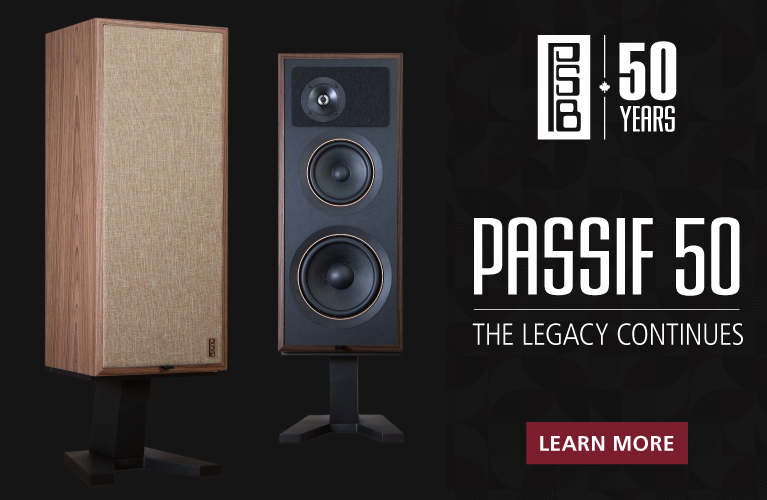Note: Measurements taken in the anechoic chamber at Canada's National Research Council can be found through this link.
When Crystal Cable began, in 2004, they shipped their cables in film canisters, which I thought a novel idea, and a good one -- the cans provided excellent protection. The cables, too, were distinctive -- superthin, silvery, and shiny, with an almost jewelry-like appearance. They looked completely unlike the garden-hose cables audiophiles are used to; yet Crystal’s advanced conductors, materials, and construction methods sent their products’ sound quality up there with the best of those bigger, bulkier makes.
From the beginning, Crystal Cable served notice that they would offer audiophiles good-sounding products that look and feel unlike any others -- and that’s still true today. That’s the vision of the company’s founder and president, Gabi Rijnveld, who is also an accomplished pianist, and whose taste and style sense have proven instrumental to her company’s success.
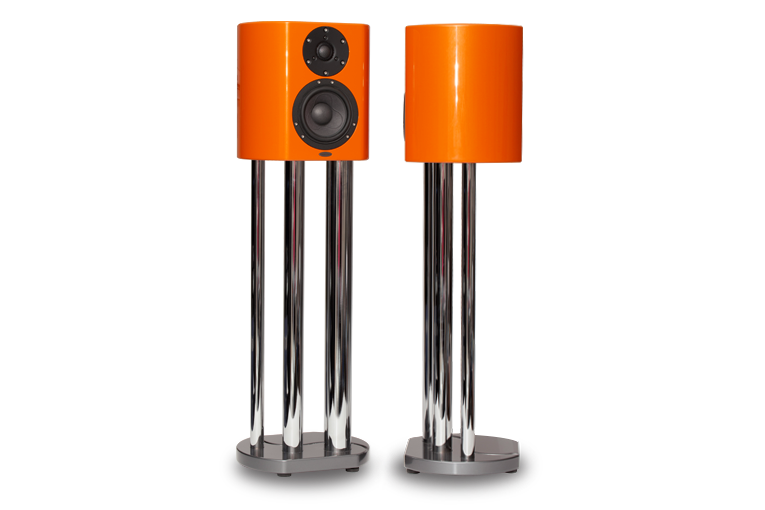
Five years ago, when Crystal began making loudspeakers, they again set out to produce something different from the rest. Their first model, the Arabesque, featured a cabinet made entirely of glass; it retailed for $65,000 USD per pair and is still available as the Arabesque Glass Master. Other than the even pricier Absolute Arabesque, which came out a few years later, no Crystal speaker since has been made of glass, but the original’s arabesque shape has been used for other Crystal speakers, including their newest, lowest-priced, smallest model to date, the Arabesque Minissimo, which costs $12,995/pair (integral stands included). That’s hardly cheap, but the Minissimo follows the Crystal tradition: It’s unlike any two-way speaker seen or heard before.
Description
When I hauled into the house the Arabesque Minissimos’ boxes -- plain, brown cardboard cartons like those you’d find containing any number of entry-level speakers -- it generated zero family interest. Then I unpacked them. My two young boys marveled at the three chromed metal legs supporting each speaker, while my wife was starry-eyed over the cabinets’ beautiful shapes and the striking color of the finish: Solar Orange. I showed her pictures of the two other stock finishes, Pearl White and Aquamarine Blue, which she also liked -- but she absolutely loved Solar Orange, which is bold yet elegant, tasteful and beautiful. You can definitely sense a woman’s touch -- Gabi Rijnveld’s? -- in the overall product design. My wife loved the Minissimo so much that, for the first time in our long history of me bringing new speakers into our home, she said she’d enjoy having a pair of them in our living room instead of where she’s wanted every other speaker to go: in my dedicated listening room.
I was taken not only by the Minissimo’s styling and color, but also by its quality of finish, which was impeccable from top to bottom, and could be used as a reference by which to judge the finish qualities of other speakers. Suffice it to say that, despite their ho-hum entrance, the Arabesque Minissimos were a big hit ’round here.

The Minissimo’s overall dimensions of 11.5”H x 10.75”W x 10.5”D refer only to the speaker’s widest and deepest points and are thus misleading. Viewed from its wider side -- the speakers are sold in mirror-imaged pairs -- the Minissimo looks like a sizable two-way speaker. But look at it from its narrow side, or from above, and you realize that the Minissimo is small. (Its name could be translated as “smaller than mini.”)
Crystal says that each cabinet’s top and sides are milled from a single block of metal-infused polymer compound, for a super-rigid structure. This means that its surfaces are without seam except when viewed from underneath -- the bottom panel, though made of the same compound, is bolted on, to grant access to the interior.
The base of the stand is just over 1” thick, with rounded sides and an S-like swoosh routed into it. It’s made of the same compound as the cabinet and finished to the same standard, but no matter the color of the speaker, the stand is always dark gray. Screw-in spikes and flat footers are supplied for, respectively, carpeted and hard floors. The hollow metal legs are sturdy, and are filled with sand at the factory to greatly reduce resonances. This also adds to the speaker’s weight, which totals about 60 pounds.
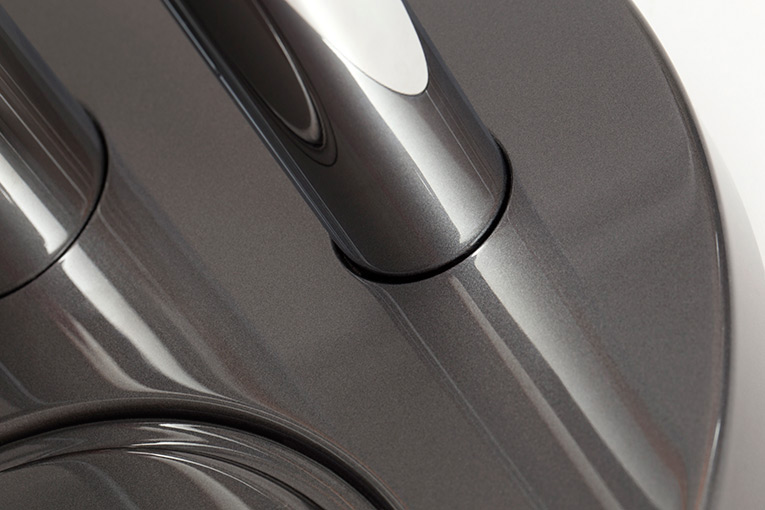
Most stand-mounted speakers end up perched atop another company’s stands, which don’t often match them. This is why I prefer a speaker with an integral, nonremovable stand -- it allows the designer to make a unified design from top panel to base. It also makes possible a sturdier structure, because everything is permanently attached -- it’s not uncommon to hear of speakers being knocked off stands if the two don’t bolt together. Having a stand of fixed height also puts the drivers at the intended listening height -- the Minissimo stands about 38” tall, with the tweeter being about 36” from the floor -- and also ensures that the midrange-woofer’s port, which is toward the front corner of the bottom panel closer to the wider side, doesn’t get covered up, which would interfere with the Minissimo’s bass response.
The drive-units are made by Scan-Speak: a 5.25” midrange-woofer with laminated paper cone, and a tweeter with a 1” beryllium dome. Other than the mesh screens that Scan-Speak supplies to cover the tweeter domes, Crystal provides no grilles for the Minissimos -- they want those drivers visible at all times.
The drivers are crossed over to each other at about 2kHz, with slopes that are said to be first-order around the crossover point, increasing to second-order an octave above and below that. Crystal says that the crossover components are of exceptionally high quality -- “huge air-cored inductors, precision silver-oil capacitors, and pure graphite resistors” -- and can withstand far more power than the drivers can, to avoid crossover-induced compression. Internal wiring is, of course, by Crystal Cable.
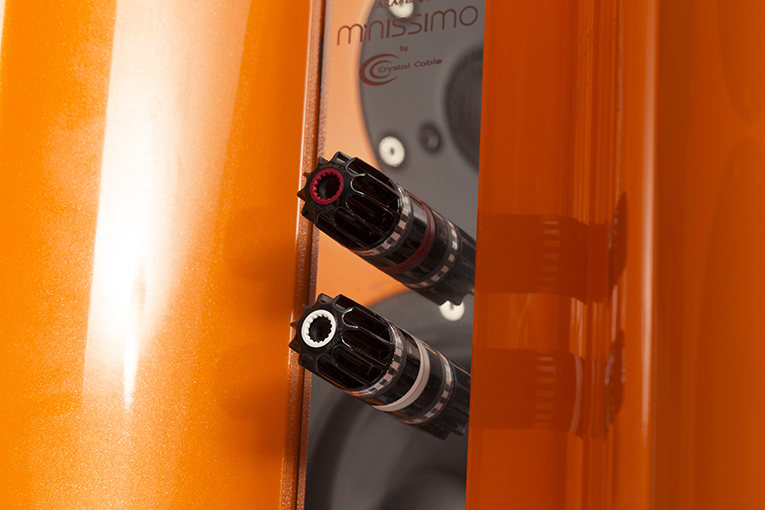
On the wider side’s rear-inside curve is a single pair of binding posts surrounded by an attractive, shiny metal plate on which is inscribed the Crystal Cable logo, the speaker’s model name and serial number, and this statement: “Handmade in The Netherlands.”
The Arabesque Minissimo’s specifications include a frequency response of 48Hz-38kHz, +/-3dB; a sensitivity of 86dB/W/m; and a nominal impedance of 8 ohms, with a minimum of 7 ohms. The Minissimo is slightly less sensitive than today’s norm of about 87dB, but its impedance is higher (I find that many of today’s speakers are 4-ohm designs that often dip lower), meaning that it shouldn’t be too tough to drive -- which I tested by using them with tubed as well as solid-state amplification (see “Sound”). Crystal claims a distortion level of less than 0.3% at an SPL of 85dB, though they specify no measuring distance or bandwidth for that figure.
Setup
I asked Gabi Rijnveld if she has any hard-and-fast rule about whether the Arabesque Minissimos’ deeper sides -- the tail of each arabesque -- should face the sidewalls or each other. She said I could do what I wanted, but that people normally face the tails out, toward the sidewalls. I tried them both ways and heard no difference, so I faced the tails outward because that’s the typical placement, separated the speakers from each other and from my listening seat by just over 7’, and toed in about 10 degrees.
For the first phase of my listening I used Simaudio Moon Evolution solid-state electronics: 650D DAC-transport, 740P preamplifier, and 870A power amplifier (300Wpc into 8 ohms). Then, to test the Minissimos with tubes, I slid in JE Audio’s Reference 1 preamplifier and VM60 mono amplifiers (60Wpc into 8 or 4 ohms). More about this below.
The wiring remained the same: AudioQuest Carbon USB interconnect, Crystal Cable CrystalConnect Standard Diamond analog interconnects, and Siltech Classic Anniversary 330L speaker cables (Siltech is Crystal Cable’s sister brand). The computer feeding the DAC was my trusty Samsung laptop running Windows 7 and JRiver Media Center 20.
Sound
Making sure speakers are the right size for a given room is crucial for best sound quality -- small speakers with limited output capabilities in too large a room can be as bad as big speakers with prodigious output capabilities in a room that’s too small. I had serious reservations about setting up the little Minissimos in my big listening room, which measures 16’ wide, 16’ from the front wall to the back of my listening chair, and another 20’ behind my chair to the rear wall -- big enough that floorstanding speakers I’ve recently reviewed, such as Magico’s S5 ($29,500-$32,600/pair), Sonus Faber’s Olympica III ($13,500/pair), and GoldenEar Technology’s Triton One ($5000/pair), have had plenty of room to breathe. Could the tiny Minissimos sufficiently energize so much space?
Much to my amazement, they could.
With the Simaudio Moon Evolution 870A amp driving the Minissimos, I played the Cowboy Junkies’ The Trinity Session (16-bit/44.1kHz FLAC, RCA) and was presented with bass output down to about 50Hz -- more than decent for such small speakers. The Arabesques also sounded surprisingly full, but not bloated or too warm, as do many speakers that are voiced to sound “big” in the bass. And keep in mind that, when I played this recording and others, I had the Minissimos pulled well out from the walls, as I do with much larger speakers. Had I pushed them much closer to the walls, the low end would have been more pronounced, because walls help to reinforce bass frequencies.
Just as impressive was the punch packed by the Minissimos’ little midrange-woofers -- important with rock. When I played the high-resolution version of the well-known title track of Jackson Browne’s Running On Empty (Elektra; originally released in 24/192 several years ago, though now I can find it only in 24/96), the Minissimos naturally lacked the weight and authority of the massive, multi-driver Triton Ones, but their sound was far more weighty than their tininess let on. More important, when the kick drum entered, I was taken aback by its strong impact, and by the fact that the Arabesques sounded tighter and more forceful in the upper bass than the Triton Ones, which sound a touch slow in comparison. That held true when I played “Wisemen,” from James Blunt’s Back to Bedlam (16/44.1 FLAC, Atlantic). The full weight of the drum kit was missing -- reproduction of the full bottom octave of the audioband fleshes that out, and the Triton Ones provide that in spades -- but the punch and slam were there.
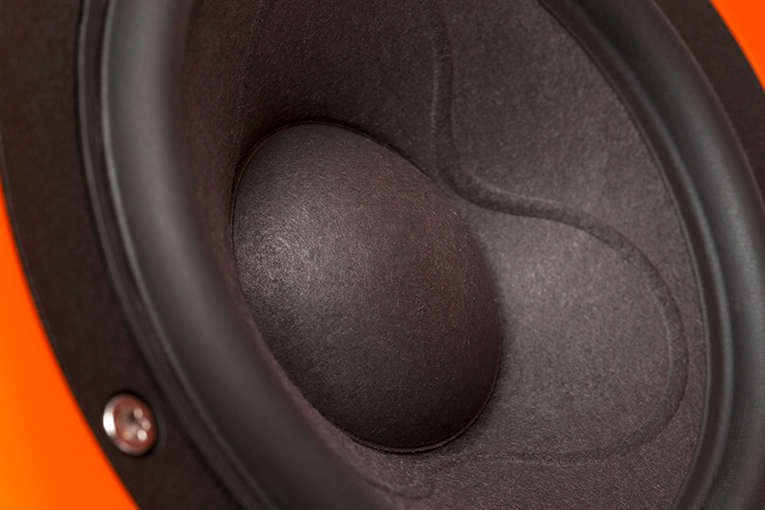
The Minissimos could also play pretty darn loud -- louder than I thought possible when I first saw them (they’re so small!) -- and, more important, loud enough to satisfy me in my big listening room. However, I was able to reach their limits with the Moon Evolution 870A amp. When I cranked up “Rosie,” from Running On Empty, the Minissimos didn’t blow up or make ghastly noises, but Browne’s voice began to sound hollow, which indicated that the drivers were compressing. I didn’t hear that hollowness in “Tears and Rain,” from Back to Bedlam, but there was a hardness that shouldn’t have been there -- another indicator that I’d pushed the Minissimos too far. That said, these SPLs were louder than most people could stand, and were produced in a very large room with the Arabesques pulled way out from the walls. I have no doubt that, set up in a space more suitable for small speakers -- a small- to mid-size room -- and with the speakers no more than 2’ or 3’ from the walls, the Minissimos would easily satisfy all but the hardest-rockin’ headbangers, or the nearly deaf.
Even more satisfying, and more in line with its price of $12,995/pair, was the Minissimo’s exceptionally pleasing tonal balance -- its sound was natural, yet quite full and fleshed out. I also admired the remarkable coherence of the sound -- the speaker’s two drivers sounded as if they were one -- and its outstanding clarity, particularly through the midrange, where voices live. Then there were the Arabesques’ soundstaging and imaging, which were on a par with the very best I’ve heard here.
About that midrange clarity: provided I didn’t exceed maximum SPL, the Minissimo sounded clearer through the mids than had the Triton Ones, and as clear and smooth as Sonus Faber’s Olympica III and Magico’s S5. For example, James Blunt’s voice in “Goodbye My Lover,” from Back to Bedlam, sounded spectacular in the way it was projected on the soundstage with the utmost transparency -- it was there. I heard a similar thing with Margo Timmins’s voice in “Mining for Gold,” from The Trinity Session, except that there was way more space around it because the venue -- the interior of a church -- had been captured by this excellent recording: it extended beyond the outer boundaries of the speakers and way past the front wall of my room, while leaving her voice rock-solidly in place at the center, with an almost holographic presence.
Listening to “Mining for Gold,” I learned that the Minissimos possessed that rare ability to project a seamless soundstage -- they left no audible cues as to the speakers’ precise positions. It was only because I could see the Minissimos that I knew that that was where all this sound must be coming from. I’ve noticed that the speakers that perform this “disappearing” act really well are those whose cabinets minimally interfere with the soundwaves they launch -- in other words, the shapes of their cabinets allow them to get out of their own way -- and that produce a minimum of the cabinet resonances that can draw attention to their locations.
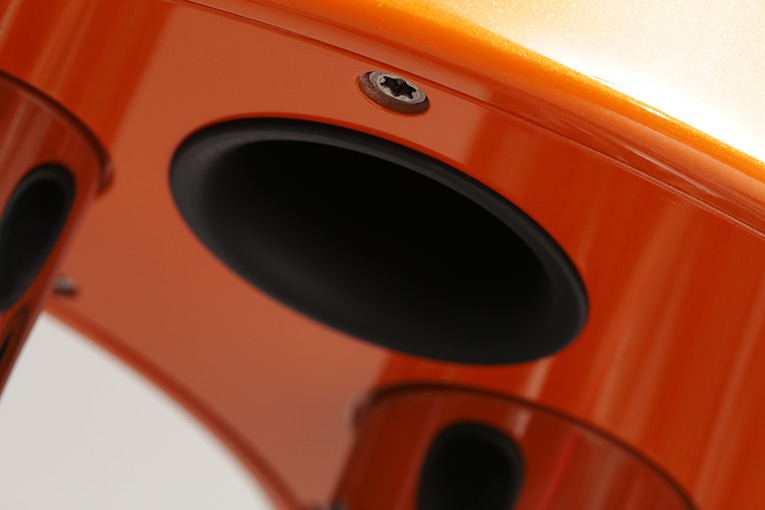
Most of us have been in the same room with a piano while its keys were being struck -- we know what that sounds like. The sound emitted when the key is struck is forceful, immediate, and precise -- it’s not quite like a gunshot, but there’s similar sort of “pop” to the sound. The Minissimos reproduced acoustic pianos better in my room than have any other speakers of similar size. For days, via Tidal’s streaming service, I listened to Valentina Lisitsa’s discs of études by Chopin and Schumann (16/44.1 FLAC, Decca), and of music by Philip Glass (16/44.1 FLAC, Decca). I marveled at how realistic her piano sounded at low to moderate volume levels, partly because of the Arabesque’s very natural tonal balance and fullness, but mostly because of how realistic the keystrokes were -- they had precision and impact, just as they do in real life, yet without the congestion or blurring I’ve heard from so many speakers, large and small. Like its cabinet, stand, and base, the sound emanating from the Minissimos was rock solid -- no blurring, overhang, or other funny stuff.
But the Minissimos couldn’t quite reproduce pianos the same way at very high volumes. When I cranked them up, they buckled a bit by sounding congested on low notes, and the mids were a little sharp. However, at normal levels -- or even at levels barely above a whisper, which is where some speakers obscure small details -- their reproduction of pianos was nothing short of astounding. Should I have been surprised? Probably not. With Gabi Rijnveld’s background as a pianist, I can’t imagine her releasing any speaker without it being able to accurately reproduce the sound of the instrument she knows best.
I was also thrilled with the Minissimo’s handling of the highs -- they were noticeably sweeter and less brittle than through the Magico S5, which also uses a beryllium-dome tweeter from Scan-Speak (but, reportedly, with modifications). “The Blower’s Daughter,” from Damien Rice’s O (16/44.1 FLAC, 14th Floor/Vector) -- the song appeared on the soundtrack of the film Closer -- has quite deep bass, a prominent midrange, and highs far brighter than they should be. When I played it through the S5s, the sibilance in the voices of Rice and his backing singers was so annoyingly piercing that I had to turn the volume way down. The sibilance was still there and very prominent through the Minissimos, but wasn’t nearly as annoying; in fact, it was still listenable even at fairly high volume levels.
Probably the most surprising thing about the Minissimos was how they sounded when hooked up to the 8-ohm taps of JE Audio’s VM60 tubed monoblocks, themselves driven by JE’s Reference 1 tubed preamp. They sounded noticeably better in almost every area. Voices were slightly more prominent; the highs sounded just as extended, but were now even sweeter; the soundstage was a tad deeper, and images on it were more focused; and, perhaps most shocking, the bass sounded more punchy and deep. I thought the resolution increased as well, but this could have been because the mids were now a bit more pronounced, so I can’t be sure of that. The only thing that the tubed electronics couldn’t do was play the Minissimos as loudly -- 60W per VM60 mono was no match for the Simaudio 870A’s 300Wpc. Still, the VM60s could drive the Minissimos loud enough for me and my room; I don’t hesitate in recommending this combo.
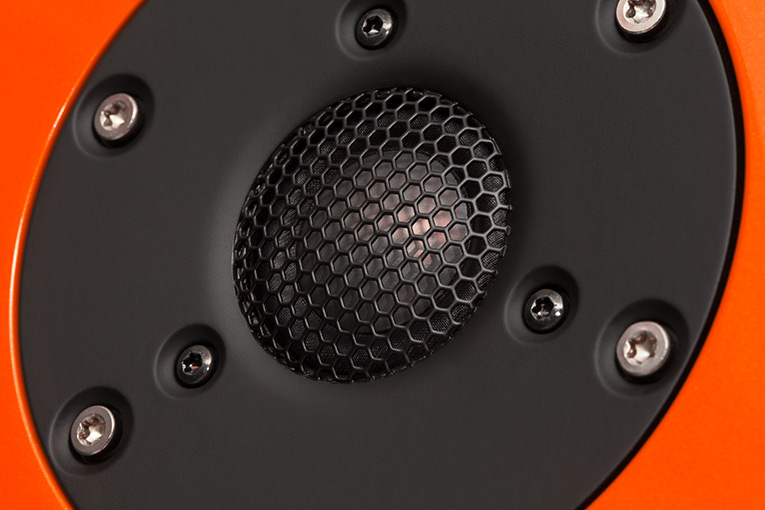
That the JE Audio tubed gear performed so well with the Minissimos against Simaudio’s solid-state gear might seem counterintuitive, particularly when you consider the difference not only in power output but in price: the 870A costs $22,000, the VM60 $6400/pair (the 740P and Reference 1 are priced roughly the same, at $9500 and $9000, respectively). Part of it could be the inherent warmth and smoothness of tube sound, which can be intoxicating to listen to. I often like that sound, and could hear a bit of it with the JEA-Crystal combo, particularly with voices. However, I think in this case there might have been another reason, one having to do with output and input impedances. Tube amps typically have higher output impedances than solid-state amps, which can cause changes in frequency response in the speakers, depending on how the speaker’s impedance varies with frequency. A speaker’s impedance can rise and fall in such a way that the changes in frequency response benefit the sound -- for example, a rise in impedance in the bass could cause a bump in the frequency response in that region, which would increase the bass punch. It’s possible that what I heard was an example of such synergy.
If you try the Minissimos, consider experimenting with tubes -- what I already thought was a great little speaker got a bit greater when I added fire bottles. The result might not be everyone’s cup of tea, but it certainly was mine -- if I were in the market for a high-performance two-way speaker, I’d buy pairs of Minissimos and VM60s, and a Reference 1.
Conclusion
If you look at Crystal Cable’s Arabesque Minissimo on the basis of only its performance as a small two-way speaker, you’ll likely admire the way it does certain things so well: its natural tonal balance, its surprising bass punch, its unexpected weight in the low end, its sweet highs, its remarkably clear midrange, and on and on. But you’ll likely wince at its high price -- usually, only larger three- or more-way floorstanders cost this much. If you simply want a two-way for performance and nothing else, then listen to the Minissimo to hear what it does -- but I suspect you’ll look elsewhere, if price is a concern.
But like the Italian company Sonus Faber, Crystal Cable’s offerings aren’t only about sound quality -- it’s that, in concert with build, finishing, and styling, that’s sets these companies and their products apart. It’s not unlike the luxury markets in cars and watches -- no one buys a Ferrari only for speed, or a Rolex only to tell time; people buy such items for their other qualities, such as look, build, appearance, even status. If you appreciate such things, there’s a good chance you’ll fall in love with this Dutch gem, as I did. I consider it the king -- or, perhaps, the queen -- of luxury-grade two-way loudspeakers.
. . . Doug Schneider
das@soundstagenetwork.com
Associated Equipment
- Speakers -- GoldenEar Technology Triton One, PSB Imagine T3, Muraudio Domain Omni PX1
- Preamplifiers -- Simaudio Moon Evolution 740P, JE Audio Reference 1
- Amplifiers -- Simaudio Moon Evolution 870A, JE Audio VM60 monoblocks
- Digital-to-analog converter -- Simaudio Moon Evolution 650D
- Computer -- Samsung laptop running Windows 7 and JRiver Media Center 20
- Digital interconnects -- AudioQuest Carbon USB
- Analog interconnects -- Crystal Cable CrystalConnect Standard Diamond
- Speaker cables -- Siltech Classic Anniversary 330L
Crystal Cable Arabesque Minissimo Loudspeakers
Price: $12,995 USD per pair.
Warranty: Five years parts and labor.
Crystal Cable
Nieuwe Stationsstraat 10
6811 KS Arnhem
The Netherlands
Phone: +31 26-353-9045
E-mail: info@crystalcable.com
Website: www.crystalcable.com
North American distributors:
Audio Plus Services (US)
156 Lawrence Paquette Industrial Drive
Champlain, NY 12919
Phone: (800) 663-9352
Website: www.audioplusservices.com
Plurison (Canada)
313 Marion Street
Le Gardeur, Quebec J5Z 4W8
Phone: (866) 271-5689
Website: www.plurison.com






















